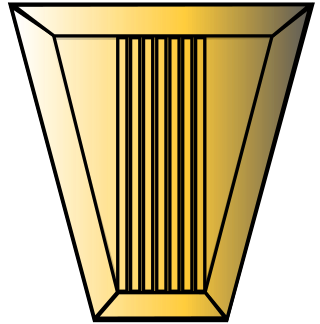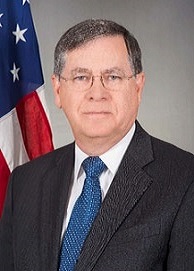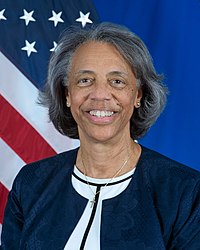
The United States secretary of the interior is the head of the United States Department of the Interior. The secretary and the Department of the Interior are responsible for the management and conservation of most federal land along with natural resources, leading such agencies as the Bureau of Land Management, the United States Geological Survey, Bureau of Indian Affairs and the National Park Service. The secretary also serves on and appoints the private citizens on the National Park Foundation Board. The secretary is a member of the United States Cabinet and reports to the president of the United States. The function of the U.S. Department of the Interior is different from that of the interior minister designated in many other countries.

The Joint Chiefs of Staff (JCS) is the body of the most senior uniformed leaders within the United States Department of Defense, which advises the president of the United States, the secretary of defense, the Homeland Security Council and the National Security Council on military matters. The composition of the Joint Chiefs of Staff is defined by statute and consists of a chairman (CJCS), a vice chairman (VJCS), the chiefs of the Army, Marine Corps, Navy, Air Force, Space Force, and the chief of the National Guard Bureau. Each of the individual service chiefs, outside their JCS obligations, works directly under the secretaries of their respective military departments, e.g. the secretary of the Army, the secretary of the Navy, and the secretary of the Air Force.
The United States order of precedence is an advisory document maintained by the Ceremonials Division of the Office of the Chief of Protocol of the United States which lists the ceremonial order, or relative preeminence, for domestic and foreign government officials at diplomatic, ceremonial, and social events within the United States and abroad. The list is used to mitigate miscommunication and embarrassment in diplomacy, and offer a distinct and concrete spectrum of preeminence for ceremonies. Often the document is used to advise diplomatic and ceremonial event planners on seating charts and order of introduction. Former presidents, vice presidents, first ladies, second ladies, and secretaries of state and retired Supreme Court justices are also included in the list.

The United States Foreign Service is the primary personnel system used by the diplomatic service of the United States federal government, under the aegis of the United States Department of State. It consists of over 13,000 professionals carrying out the foreign policy of the United States and aiding U.S. citizens abroad. The current director general is Marcia Bernicat.

The Bureau of Intelligence and Research (INR) is an intelligence agency in the United States Department of State. Its central mission is to provide all-source intelligence and analysis in support of U.S. diplomacy and foreign policy. INR is the oldest civilian element of the U.S. Intelligence Community and among the smallest, with roughly 300 personnel. Though lacking the resources and technology of other U.S. intelligence agencies, it is "one of the most highly regarded" for the quality of its work.
Diplomatic rank is a system of professional and social rank used in the world of diplomacy and international relations. A diplomat's rank determines many ceremonial details, such as the order of precedence at official processions, table seatings at state dinners, the person to whom diplomatic credentials should be presented, and the title by which the diplomat should be addressed.

The Senior Executive Service (SES) is a position classification in the civil service of the United States federal government equivalent to general officer or flag officer rank in the U.S. Armed Forces. It was created in 1979 when the Civil Service Reform Act of 1978 went into effect under President Jimmy Carter.

David Michael Satterfield is an American diplomat and ambassador, who has served extensively in the Middle East, including the Persian Gulf area, Lebanon, and Iraq. He later served as a senior advisor on Iraq for Secretary of State Condoleezza Rice and was director general of the Multinational Force and Observers, the peacekeeping force for the Sinai Peninsula from June 2009 until August 2017. He was chargé d'affaires to Egypt from August 2013 to January 2014 and was subsequently Special Advisor to the Secretary of State for Libya. From September 2017 to June 2019 he served as the acting assistant secretary of state for Near Eastern affairs, and was confirmed as U.S. ambassador to Turkey on June 27, 2019.
Assistant Secretary of State (A/S) is a title used for many executive positions in the United States Department of State, ranking below the under secretaries. A set of six assistant secretaries reporting to the under secretary for political affairs manage diplomatic missions within their designated geographic regions, plus one assistant secretary dealing with international organizations and one equivalent as the coordinator/ambassador at large for counterterrorism. Assistant secretaries usually manage individual bureaus of the Department of State. When the manager of a bureau or another agency holds a title other than assistant secretary, such as "director," it can be said to be of "assistant secretary equivalent rank." Assistant secretaries typically have a set of deputies, referred to as deputy assistant secretaries (DAS).

Richard A. Boucher is an American diplomat who was deputy secretary-general of the Organisation for Economic Co-operation and Development (OECD) from 2009 until 2013. He took up post on November 5, 2009. Prior to joining OECD, he was the Assistant Secretary of State for South and Central Asian Affairs, a post he took up on February 21, 2006. The Bureau of South Asian Affairs was expanded to include the nations of Central Asia shortly before his confirmation.

David Maclain Hale is an American diplomat and career ambassador, who previously served as the United States Under Secretary of State for Political Affairs. He is currently a Distinguished Diplomatic Fellow at the Wilson Center, on detail from the Department of State.

William Caldwell Harrop is an American diplomat. Harrop served for 39 years as a Foreign Service Officer, with postings as United States ambassador to Guinea, Kenya and the Seychelles, the Congo (Kinshasa), and Israel.
Executive Schedule is the system of salaries given to the highest-ranked appointed officials in the executive branch of the U.S. government. The president of the United States appoints individuals to these positions, most with the advice and consent of the United States Senate. They include members of the president's Cabinet, several top-ranking officials of each executive department, the directors of some of the more prominent departmental and independent agencies, and several members of the Executive Office of the President.
The United States Department of State, like other agencies of the U.S. federal government, gives civilian decorations for outstanding service, sacrifice, or heroism. The criteria for the awards are set down in 3 FAM 4820 - Foreign Affairs Manual, 3 FAM - Personnel, section 3 FAM 4800 Department Awards Program.

The Superior Honor Award is an award of the United States Department of State. Similar versions of the same award exist for the former U.S. Information Agency, Arms Control and Disarmament Agency, and USAID. It is presented to groups or individuals in recognition of a special act or service or sustained extraordinary performance covering a period of one year or longer.
The Senior Foreign Service (SFS) comprises the top four ranks of the United States Foreign Service. These ranks were created by the Foreign Service Act of 1980 and Executive Order 12293 in order to provide the Foreign Service with senior grades equivalent to general and flag ranks in the military and naval establishments, respectively, and to grades in the Senior Executive Service. Like military ranks and other Foreign Service ranks, the Senior Foreign Service grade system assigns rank in person, not rank in position.

Francis Xavier Taylor was the Under Secretary of Homeland Security for Intelligence and Analysis at the U.S. Department of Homeland Security (DHS), nominated by President Obama in 2014. In that role, he provided the Secretary, DHS senior leadership, the DHS components, and state, local, tribal and private sector partners with homeland security intelligence and information they need to keep the country safe, secure and resilient. DHS Office of Intelligence and Analysis is a member of, and the Department’s liaison to, the U.S. Intelligence Community.

The Executive Secretary of the United States Department of State is the Director of the Executive Secretariat. The position holds a rank equivalent to an Assistant Secretary. Each Executive Secretary is appointed by the Secretary of State.

Alaina B. Teplitz has served as the Assistant Secretary of State for Administration since 2021. She served as U.S. Ambassador to Sri Lanka and Maldives from 2018–2021 and U.S. Ambassador to Nepal from 2015–2018. A career member of the Senior Foreign Service with the rank of Career Minister, she joined the State Department in 1991 and is the recipient of numerous Superior and Meritorious Honor Awards.















